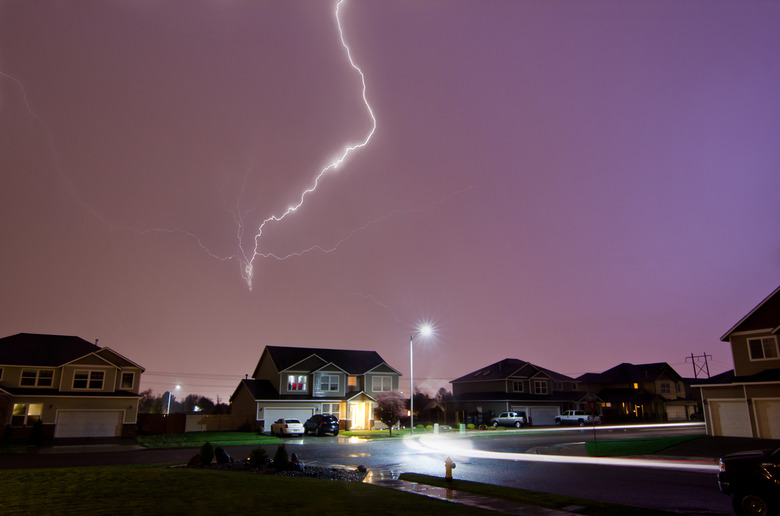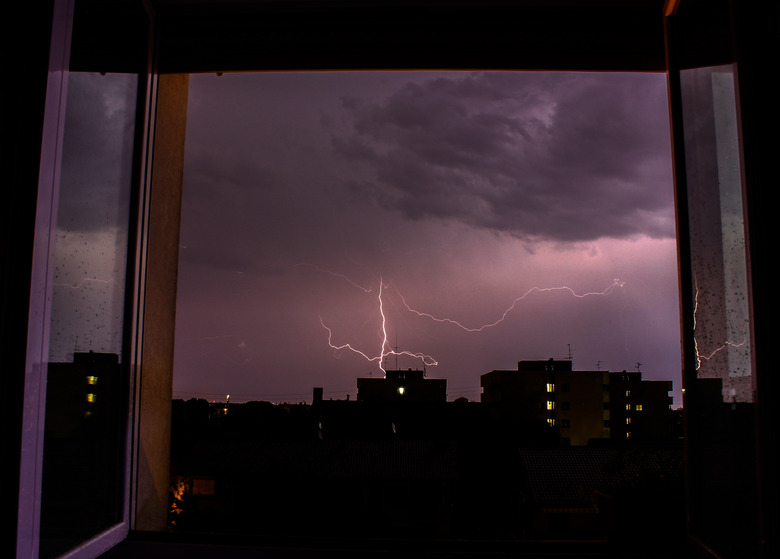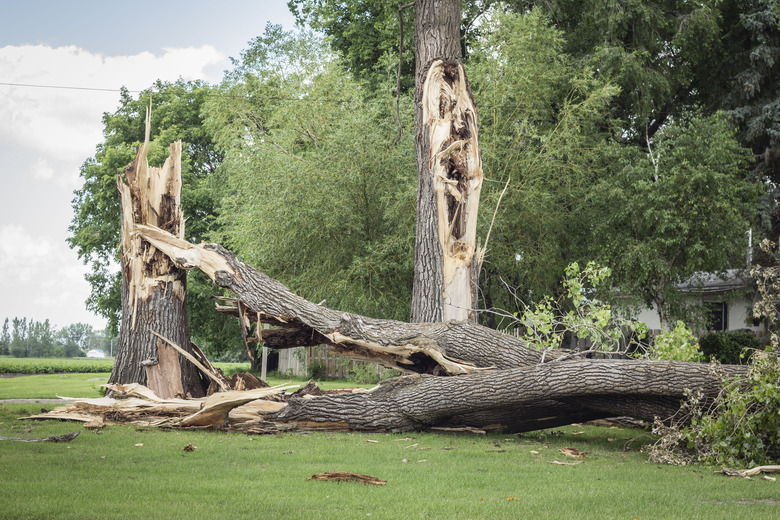7 Lightning Safety Tips: How To Stay Safe At Home During A Storm
We may receive a commission on purchases made from links.
It's natural to assume that when a thunderstorm strikes, you'll be OK if you follow common sense lightning safety rules — like discontinue your outdoor activities; avoid touching metal objects, isolated trees and bodies of water; leave open areas; and go inside a safe building. While these are all good practices, it's important to know that the danger hasn't passed just because you're at home or you sought out a safe shelter. In fact, according to the Centers for Disease Control and Prevention, one-third of injuries from lightning strikes happen indoors.
While it's easy to brush aside lightning safety tips because the risk of being struck by lightning is less than one in a million, keep in mind that choices you make can greatly change these odds. Lightning strikes may be relatively rare, but they are one of the leading causes of weather-related death. The National Oceanic and Atmospheric Administration says lightning kills an average of 51 people in the United States every year. Following some basic lightning safety rules — both inside and out — will keep you safe when there's a storm.
1. Avoid Touching Water
1. Avoid Touching Water
You could probably guess that water and metal pipes are both highly conductive, but you may be surprised to learn that lightning can actually travel through your pipes and shock you in your kitchen or bathroom. Do not bathe, shower or wash dishes during a thunderstorm. While you might not be able to avoid using the toilet altogether, try not to do so unless necessary and consider using hand sanitizer instead of washing your hands in the sink to minimize shock risk while still maintaining proper hygiene.
2. Do Not Use Electronics
2. Do Not Use Electronics
Just as electricity can travel through your pipes, it can also go through electrical cables, television cables and antenna systems. This means you should avoid using corded phones, computers, washers, dryers or anything else connected to an outlet. It is safe to use cordless phones, laptops, tablets and cellphones as long as they are not plugged in. You can also use televisions and gaming systems with wireless controllers as long as you don't touch the plugged-in parts of devices themselves.
3. Watch Out for Concrete
3. Watch Out for Concrete
While concrete doesn't conduct much electricity on its own, concrete walls and floors used in homes often contain metal bars or wires that conduct electricity. This is why you should avoid making contact with concrete in your home as much as possible. Be careful entering areas that have mostly concrete floors or walls, such as garages and basements, and never lean against a concrete wall or lay on a concrete floor.
4. Avoid Windows, Doors and Porches
4. Avoid Windows, Doors and Porches
Some people may have a hard time not watching a beautiful lightning flash during a storm, but you don't want to do something that will put you in danger just so you can enjoy the view. Not only can the high winds and hail common during thunderstorms break the glass in your windows but the metal frames used on most exterior windows and doors can conduct electricity. So, close the blinds of your windows and sliding glass doors so that if the glass does break, the damage will be contained as close to the window as possible. Stay away from windows and doors as much as possible.
Also, avoid standing on your porch. Only fully enclosed buildings are safe during thunderstorms. Since porches have open sides, lightning can still arc in through the open spaces and strike you.
5. Don’t Forget About Your Pets
5. Don't Forget About Your Pets
The absolute worst place a pet can be during a thunderstorm is chained to a tree or inside a dog run surrounded by all-metal fencing. Do not assume that a dog house or similar structure will provide substantial safety for your pet, as these are rarely grounded, and they have open doors, meaning they will do little more than protect your pet from the rain. Watch out for cats who may hide under vehicles; the metal bodies and chassis can conduct electricity right above their heads.
Take your pets indoors during thunderstorms to help keep them safe from lightning strikes and remember that just as an open garage or a porch does not provide sufficient safety for humans during a lightning storm, they will not protect your pet either. If your pet is nervous during the storm, provide them a safe place in your home to hide, such as a crate, but leave the door open so they won't hurt themselves if they panic and start trying to scratch or bite their way out.
6. Stay Inside Until It’s Safe
6. Stay Inside Until It's Safe
The National Weather Service has a simple slogan to remember when it comes to lightning safety: "When thunder roars, go indoors." However, it's not enough to just go inside during a thunderstorm. In fact, lightning often strikes as far as 25 miles away from the heart of a storm, which is why you should go inside as soon as you notice that a thunderstorm is near (or when you hear about one approaching) and stay indoors for at least 30 minutes after you hear the last clap of thunder. If you hear another rumble, start your timer over again. Do not make the mistake of leaving just because the rain stops pouring.
When you do go outside, take stock of your situation and look for fallen debris or downed power lines that could present a safety risk. Keep your pets on a leash until you're sure your yard is safe and the fence is uncompromised. If you see a downed power line, call 911 immediately and do not go near the hazard. If you smell gas, call your local gas company or fire department immediately and leave the area until the emergency responder has declared the area safe again.
7. Future Lightning Safety Precautions
7. Future Lightning Safety Precautions
You never know when a lightning strike will hit your home, but you can practice lightning preparedness by acting preemptively to reduce danger to yourself and your home. Trim back dead and overhanging tree branches that could fall on your home if struck by lightning. To protect your devices, which can be damaged while plugged in whether or not they are in use, consider equipping your home with whole-house surge protectors.
If you have more than 30 minutes of warning prior to a thunderstorm, you may want to bring in outdoor furniture that could be blown around in severe weather. Also unplug your electronics to protect them from lightning strikes and charge your portable electronics, such as laptops, cellphones and tablets, so you can have them during the storm. Never unplug anything during a storm, though, as this can put you in danger. Have flashlights and battery-powered lanterns available in case there is a power outage in your area.
If you live in an area with frequent thunderstorms, if your home is very tall or if there are trees taller than your home located less than 10 feet away from the house, consider installing a lightning rod. While the device won't reduce the risk of lightning striking your home, it will intercept the voltage and redirect it into the ground. By doing this, you minimize the potential lightning damage to your home, including fire, explosions and electrical surges.
References
- Mr. Electric: Should I Install a Lightning Rod?
- Geico: Stay Safe In A Severe Thunderstorm
- Tampa Bay Times: Six Ways to Stay Safe in Your House if Lightning is Striking Outside
- Nationwide: How to Stay Safe in a Thunderstorm
- National Oceanic and Atmospheric Administration: Lightning Safety Awareness Week
- Centers for Disease Control and Prevention: Lightning: Lightning Safety Tips
- Centers for Disease Control and Prevention: When Thunder Roars, Go Indoors!


